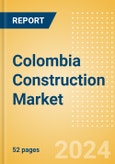3 Context
3.1 Economic Performance
3.2 Political Environment and Policy
3.3 Demographics
3.4 Risk Profile
4 Construction Outlook
4.1 All Construction
- Outlook
- Latest news and developments
- Construction Projects Momentum Index
4.2 Commercial Construction
- Outlook
- Project analytics
- Latest news and developments
4.3 Industrial Construction
- Outlook
- Project analytics
- Latest news and developments
4.4 Infrastructure Construction
- Outlook
- Project analytics
- Latest news and developments
4.5 Energy and Utilities Construction
- Outlook
- Project analytics
- Latest news and developments
4.6 Institutional Construction
- Outlook
- Project analytics
- Latest news and developments
4.7 Residential Construction
- Outlook
- Project analytics
- Latest news and developments
5 Key Industry Participants
5.1 Contractors
5.2 Consultants
7 Appendix
7.1 What is this Report About?
7.2 Definitions
7.3 CRI Methodology
- About the Analyst
- Contact the Publisher
List of Tables
Table 1: Construction Industry Key Data
Table 2: Colombia, Key Economic Indicators
Table 3: Colombia, Commercial Construction Output by Project Type (Real % Change), 2020-29
Table 4: Colombia, Top Commercial Construction Projects by Value
Table 5: Colombia, Industrial Construction Output by Project Type (Real % Change), 2020-29
Table 6: Colombia, Top Industrial Construction Projects by Value
Table 7: Colombia, Infrastructure Construction Output by Project Type (Real % Change), 2020-29
Table 8: Colombia, Top Infrastructure Construction Projects by Value
Table 9: Colombia, Energy and Utilities Construction Output by Project Type (Real % Change), 2020-29
Table 10: Colombia, Top Energy and Utilities Construction Projects by Value
Table 11: Colombia, Institutional Construction Output by Project Type (Real % Change), 2020-29
Table 12: Colombia, Top Institutional Construction Projects by Value
Table 13: Colombia, Residential Construction Output by Project Type (Real % Change), 2020-29
Table 14: Colombia, Top Residential Construction Projects by Value
Table 15: Colombia, Key Contractors
Table 16: Colombia, Key Consultants
Table 17: Colombia, Construction Output Value (Real, $ Million)
Table 18: Colombia, Construction Output Value (Nominal, COP Billion)
Table 19: the analyst Construction Market Definitions
Table 20: Risk Dimensions
Table 21: Ratings, Scores and Definitions
List of Figures
Figure 1: Latin America, Construction Output (Real % Change), 2023-29
Figure 2: Colombia, Construction Output by Sector (Real % Change), 2023-25 and 2026-29
Figure 3: Colombia, Risk Summary
Figure 4: Colombia, Risk Regional Comparison
Figure 5: Colombia, Construction Output Value (Real, $ Million, 2022 Prices and Exchange Rate), 2020-29
Figure 6: Colombia, Construction Output Value, by Sector (Real, $ Million), 2020-29
Figure 7: Colombia, Construction Value-add (COP Billion, 2015 Chained Prices), YoY % Change
Figure 8: Colombia, Gross Capital Formation (COP Billion, 2015 Chained Prices)
Figure 9: Colombia, Total Area Approved for Construction, In Thousand m2
Figure 10: Colombia, Building Construction Cost Index (2021=100)
Figure 11: Colombia, Number of People Employed in The Construction Industry, In Thousands
Figure 12: Colombia, Producer Price Index (PPI) for Construction Materials (2014=100)
Figure 13: Colombia, Production and Sales of Cement, In Tons
Figure 14: Colombia, Production of Ready-Mixed Concrete, In Thousand m3
Figure 15: Colombia, Construction Projects Momentum Index
Figure 16: Latin America, Construction Projects Momentum Index
Figure 17: Colombia, Commercial Construction Output by Project Type (Real, $ Million), 2020-29
Figure 18: Colombia, Commercial Construction Projects Pipeline, Value by Stage ($ Million)
Figure 19: Colombia, Retail Sales Index, In Real Prices (2019=100)
Figure 20: Colombia, Non-Resident Visitor Arrivals, In Thousands
Figure 21: Colombia, Value-add of Wholesale and Retail and Repair of Motor Vehicles and Motorcycles, Transportation and Storage, and Accommodation and Food Services Activities (2015 Chained Prices, COP Billion)
Figure 22: Colombia, Value-add of Artistic, Entertainment and Recreation, and Other Service Activities (COP Billion, 2015 Chained Prices)
Figure 23: Colombia, Industrial Construction Output by Project Type (Real, $ Million), 2020-29
Figure 24: Colombia, Industrial Construction Projects Pipeline, Value by Stage ($ Million)
Figure 25: Colombia, Manufacturing Value-add (COP Billion, 2015 Chained Volume Measures)
Figure 26: Colombia, Industrial and Manufacturing Production Indices (2018=100)
Figure 27: Colombia, Total Exports ($ Million)
Figure 28: Colombia, Infrastructure Construction Output by Project Type (Real, $ Million), 2020-29
Figure 29: Colombia, Infrastructure Construction Projects Pipeline, Value by Stage ($ Million)
Figure 30: Colombia, Value-add of Civil Engineering Works (COP Billion, 2015 Chained Prices)
Figure 31: Colombia, Civil works Production Index (Q1 2021=100)
Figure 32: Colombia, Energy and Utilities Construction Output by Project Type (Real, $ Million), 2020-29
Figure 33: Colombia, Energy and Utilities Construction Projects Pipeline, Value by Stage ($ Million)
Figure 34: Colombia, Value-add of Supply of Electricity, Gas, Steam and Air Conditioning and Water Distribution, Wastewater Evacuation and Treatment and Waste Management and Environmental Sanitation Activities, (COP Billion, 2015 Chained Volume Measures)
Figure 35: Colombia, Information and Communication Value-Add (COP Billion, 2015 Chained Volume Measures)
Figure 36: Colombia, Institutional Construction Output by Project Type (Real, $ Million), 2020-29
Figure 37: Colombia, Institutional Construction Projects Pipeline, Value by Stage ($ Million)
Figure 38: Colombia, Value-Add of Education, Human Healthcare and Social Service Activities, (COP Billion, 2015 Chained Volume Measures)
Figure 39: Colombia, Value-add of Public Administration and Defense and Compulsory Social Security Plans (COP Billion, 2015 Chained Prices)
Figure 40: Colombia, Residential Construction Output by Project Type (Real, $ Million), 2020-29
Figure 41: Colombia, Residential Construction Projects Pipeline, Value by Stage ($ Million)
Figure 42: Colombia, Real Estate Value-add, (COP Billion, 2015 Chained Volume Measures)
Figure 43: Colombia, Total Area Approved for Housing, In Thousand m2
Figure 44: Colombia, Total Balance of Mortgage Portfolio, In Current Prices, In COP Billion, % Change YoY
Figure 45: Colombia, New Housing Price Index (IPVN), Q4 2020=100, % Change YoY
Figure 46: Colombia, Disbursement for Home Purchase, In COP Billion, Constant Prices
Figure 47: Colombia, Residential Building Construction Index (2021=100)
Figure 48: Colombia, Headquarters of Key Contractors (% of Total Project Pipeline)
Figure 49: Colombia, Headquarters of Key Consultants (% of Total Project Pipeline)








